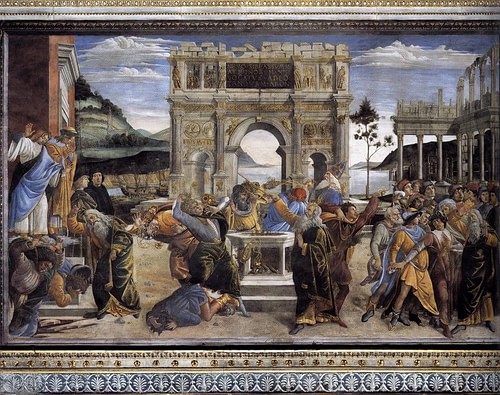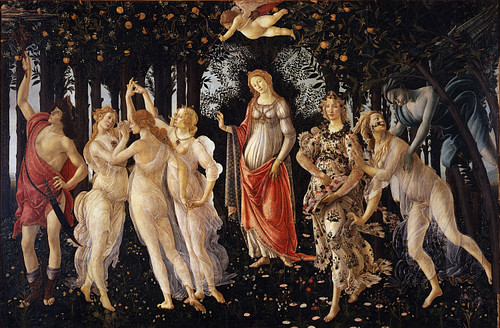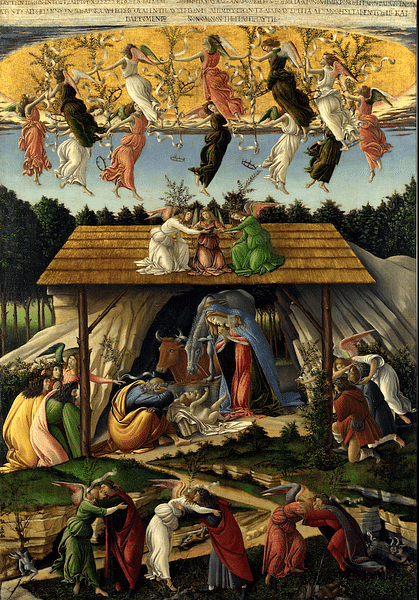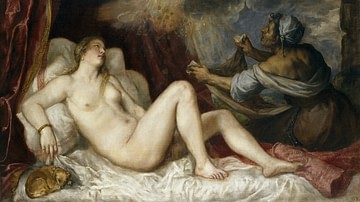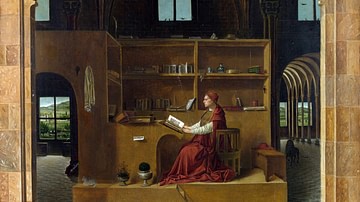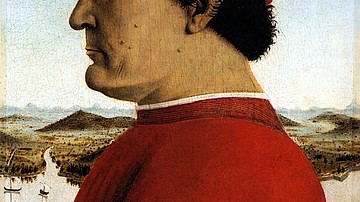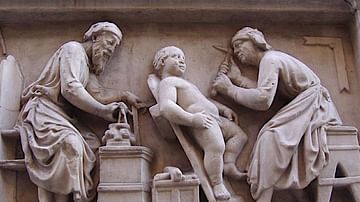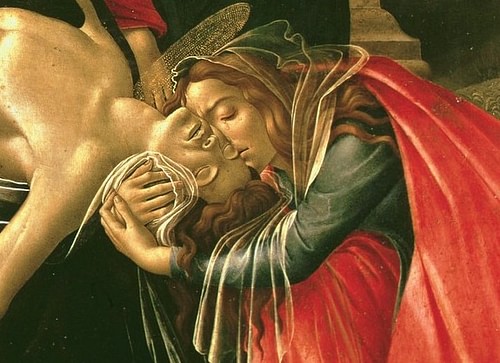
Sandro Botticelli (1445-1510 CE), real name Alessandro di Mariano Filipepi, was an Italian artist of the early Renaissance. A prolific painter, especially of altarpieces and works with a religious theme, Botticelli's most famous work today is, ironically, the mythological Birth of Venus which is now on display in the Uffizi Gallery of his native Florence. Widely regarded as one of the greatest painters in Western art, Botticelli blended colour, form, and perspective to produce religious and secular works with outstanding visual poetry. Reinterpreting and intertwining traditional imagery from classical mythology and Christian art, his paintings are often open to multiple interpretations.
Early Life
Botticelli was born in Florence in 1445 CE, his given name being Alessandro di Mariano dei Filipepi. He became known as Botticelli because that was the nickname of his elder brother Giovanni. The future artist's first work experience was as an apprentice to a goldsmith. As a teenager, Botticelli then trained as a painter in the workshop of the Florentine artist and former monk Filippo Lippi (c. 1406-1469 CE) who was noted for his frescoes and altarpieces (as well as running off with a nun and having two children with her). Other early influences on Botticelli came from his time spent with the Florentine artists Andrea del Verrocchio (c. 1435-1488 CE) and the brothers Antonio (c. 1432-1498 CE) and Piero del Pollaiuolo (c. 1441 - c. 1496 CE), all of whom had noted workshops where younger artists went to learn their trade. Botticelli was likely at Verrocchio's workshop when Leonardo da Vinci (1452-1519 CE) was there. The result of these formative years was that Botticelli's contemporary and later work displays a concern with graceful figures and capturing ornamental detail. An excellent example is the 1470 CE Fortitude (Uffizi Gallery, Florence).
An Established Artist
The artist was popular and mixed public works with private commissions, especially for the powerful Medici family of Florence. For the latter, Botticelli explored many themes from Roman and Greek mythology such as the Primavera, now in the Uffizi (see below). Between 1480 and 1484 CE, Botticelli produced perhaps his most famous work, the Birth of Venus (see below). Religious works were not abandoned and he attracted the admiration of Pope Sixtus IV (r. 1471-1484 CE) who commissioned Botticelli to decorate a part of the interior of the Sistine Chapel in Rome in the early 1480s CE. The chapel benefitted from the attention of many great artists, and Botticelli was given a lower wall space to show scenes from the Old Testament, which include the Life of Moses panel and a remarkably accurate depiction of Rome's Arch of Constantine.
Portraits
Botticelli returned to Florence in the mid-1480s CE where he had a large workshop producing all manner of works. The artist's private devotional paintings were especially popular. An example of this genre is the Madonna of the Pomegranate (c. 1487 CE, Uffizi). Like many successful Renaissance artists, Botticelli was often commissioned to paint portraits. An interesting example of this type of work is a portrait of a young man of unknown name who is prominently displaying to the viewer a large gold medallion showing the profile of Cosimo the Elder, a member of the Medici family. Such displays of support are an insight into the politics of Florence where it was obviously considered a good career move to have oneself painted in such obvious support of the ruling family. The portrait, dating to c. 1475 CE, is now in the Uffizi Gallery.
Finally, Botticelli's skill at capturing the individual character of faces can be seen even in his larger composite works where background figures stand out as impressive portraits in their own right. An excellent example of this attention to background detail can be seen in his c. 1475 CE Adoration of the Magi in the Uffizi. The painting is a veritable gallery of prominent members of the Medici family while the figure on the far right may even be Botticelli himself.
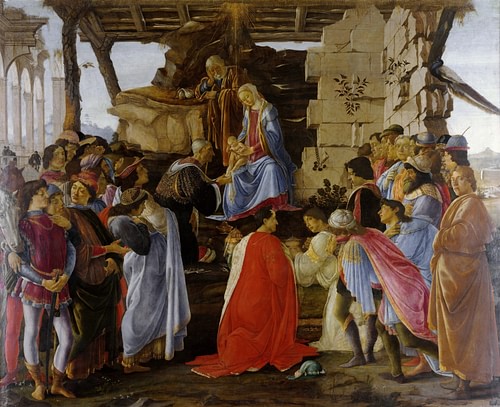
Later Career
In the 1490s CE Botticelli famously produced illustrations for the Inferno section of Dante Alighieri's (1265-1321 CE) literary masterpiece the Divine Comedy. Also in the 1490s CE, Botticelli was greatly influenced by the ideas of the theologian and preacher Girolamo Savonarola (1452-1498 CE), who was an outspoken critic of what he saw as the decline in morality and neglect of religion in Florence and elsewhere. Botticelli was thus inspired to concentrate thereafter on religious paintings. The classics-laden c. 1498 CE Calumny of Apelles and the powerful yet enigmatic 1500 CE Mystic Nativity, with their message that rulers should heed the dangers of a disconnected secular world, are typical works of this period (see below).
Reputation & Legacy
Botticelli was in constant demand throughout his career and he was recognised in his own lifetime as a genius of painting. Technically excellent at capturing anatomy and perspective, as well as being a master of all types of colouring, the artist's work was most admired for its overall harmonious effect. Botticelli was also a master of capturing emotions, see, for example, the face of Mary Magdalene in his 1490-2 CE Lamentation over the Dead Christ now in Munich's Alte Pinakothek.
Another defining feature of his work throughout his career is the suspension of disbelief expected of the viewer. Botticelli's scenes, by toying with perspective and plains of view, are very often given an artificial quality which creates a sense of being not of this world, an entirely appropriate effect given that his two main subjects are either stories from mythology with an allegorical importance to the present or religious art for devotional purposes. This breaking away from the confines of classical art would be similarly pursued by subsequent Renaissance artists.
Masterpieces
Primavera
The Primavera painting, meaning Spring, has puzzled art historians for centuries as opinions vary wildly on its precise meaning. The painted wood panel was perhaps commissioned by Lorenzo di Pierfrancesco de' Medici and completed around 1482 CE. It is a large piece, measuring 315 x 203 centimetres (124 x 80 inches). The identity of the central figure with a red cloak, the presence of what could be the Three Graces or the Hours, and the figure of a shady character dragging off a young woman on the far right of the picture are all particular points of debate as to their significance in relation to each other and the work's title.
The central lady is most likely Venus given the presence of a cupid above her, but the halo that surrounds her head, formed by the gaps in the bushes behind her, may indicate this is the Virgin Mary or perhaps an amalgamation of the two. The Three Graces of Greek mythology would be an appropriate interpretation of the dancing trio since they were associated with Aphrodite/Venus and spring flowers. The dark blue ghostly figure on the far right may be a representation of the wind god Zephyrus who is abducting what must then be the spring nymph Chloris. The figure on the far left picking an orange may be the messenger god Hermes/Mercury, who also represented fertility. The whole purposely artificial scene resembles a tapestry, particularly given the flowers in the foreground and the orange grove behind and above the human figures, who do not interact with each other at all. An additional clue to the painting's significance may be in the commissioner, who was that year to be married to Semiramide d'Appiano. Perhaps, then, the painting is an allegory of marriage and the spring honeymoon that follows such a union.

The Birth of Venus
Painted in the early 1480s CE, the Birth of Venus has become an iconic work of art, copied and referenced in countless other works ever since. The work is a tempera and oil on canvas of impressive dimensions: 279 x 175 centimetres (110 x 69 inches). The painting depicts the story of the birth of Aphrodite/Venus from classical mythology and, like the Primavera, the Birth of Venus is on display in the Uffizi Gallery of Florence.
The whole scene is given a dynamic sense of movement by the zephyr winds leaning towards the picture's centre, the hair of Venus blowing to the right and the goddess' assistant (one of the Hours?) reaching across with a billowing robe. The many flowers seemingly cast randomly in the wind are another aid in this effect. Further, the figures are all on the same plain and so seem to float against an unrealistic marine background. It is almost as if Botticelli is intent on recreating the flatness seen in the only other place such iconography was then known: Greek, Roman, and Etruscan pottery. It is precisely this quality which gives the work its unworldly effect. The posture of Venus and the position of her hands, however, are entirely taken from Greek and Roman sculpture, the Venus pudica. The work as a whole is, then, a typical example of Renaissance art, where classical themes and imagery are explored and developed to create an entirely new interpretation of familiar iconography.
Mystic Nativity
The Mystic Nativity is tempera on canvas and measures 108.5 x 75 centimetres (42.5 x 29.5 inches). The painting is now in the National Gallery, London. On the surface, it is a traditional nativity scene, at least across its central band, with shepherds and kings visiting the newborn Jesus Christ in a stable all forlorn. The top and bottom of the painting are, though, very different. Angels seem to dance in a golden circle above the stable, while below it are three more angels, each one embracing a man. There are also a number of demons who seem to be at a loss what to do with themselves amongst all this joy.
The picture is topped by an inscription in Greek which states that Botticelli made the work in 1500 CE and is living through 'the second woe of the Apocalypse' (Rundle, 56), a reference to the gloomy predictions on humanity's demise that Savonarola spouted from his pulpit. The overload of angels in the painting could even be a reference directly to Savonarola whose nickname was 'the angelic one'. Yet again, then, Botticelli is combining traditional imagery with his own unique ideas to suspend reality and give his work multiple avenues of interpretation, a classic feature of the best of Renaissance art.
